Combined Effects of Substrate Depth and Vegetation of Green Roofs on Runoff and Phytoremediation under Heavy Rain
Abstract
:1. Introduction
2. Materials and Methods
2.1. Study Site
2.2. Experimental Setup and Sampling
2.3. Runoff Reduction and Quality Analyses
2.4. Statistics
3. Results
3.1. Runoff Reduction
3.2. Runoff Quality
4. Discussion
4.1. Runoff Reduction
4.2. Runoff Quality (pH, EC, Turbidity, and Heavy Metals)
5. Conclusions
Author Contributions
Funding
Institutional Review Board Statement
Informed Consent Statement
Data Availability Statement
Conflicts of Interest
References
- Eksi, M.A. Field study to evaluate the runoff quantity and stormwater retention of a typical extensive green roof in Bakekoy, Istanbul. Environ. Protect. Eng. 2013, 39, 79–89. [Google Scholar] [CrossRef]
- Shafique, M.; Kim, R.H.; Kwon, K.H. Green roofs for stormwater management in higly urbanized area: The case of Seoul, Korea. Sustainability 2018, 10, 584. [Google Scholar] [CrossRef]
- Liu, H.Q.; Kong, F.H.; Yin, H.W.; Middel, A.; Zheng, X.D.; Huang, J.; Xu, H.R.; Wang, D.; Wen, Z.H. Impacts of green roofs on water, temperature, and air quality: A bibliometric review. Build. Environ. 2021, 196, 107794. [Google Scholar] [CrossRef]
- Villarreal, E.L.; Bengtsson, L. Response of a Sedum green-roof to individual rain events. Ecol. Eng. 2005, 25, 1–7. [Google Scholar] [CrossRef]
- Gregoire, B.G.; Clausen, J.C. Effect of a modular extensive green roof on stormwater runoff and water quality. Ecol. Eng. 2011, 37, 963–969. [Google Scholar] [CrossRef]
- Ercolani, G.; Chiaradia, E.A.; Gandolfi, C.; Castelli, F.; Masseroni, D. Evaluating performances of green roofs for stormwater runoff mitigation in a high flood risk urban catchment. J. Hydrol. 2018, 566, 830–845. [Google Scholar] [CrossRef]
- Vijayaraghavan, K.; Raja, F.D. Design and development of green roof substrate to improve runoff water quality: Plant growth experiments and adsorption. Water Res. 2014, 63, 94–101. [Google Scholar] [CrossRef]
- Liu, W.; Wei, W.; Chen, W.P.; Deo, R.C.; Si, J.H.; Xi, H.Y.; Li, B.F.; Feng, Q. The impacts of substrate and vegetation on stormwater runoff quality from extensive green roofs. J. Hydrol. 2019, 576, 575–582. [Google Scholar] [CrossRef]
- Lee, J.Y.; Lee, M.J.; Han, M. A pilot study to evaluate runoff quantity from green roofs. J. Environ. Manag. 2015, 152, 171–176. [Google Scholar] [CrossRef]
- Alim, M.A.; Rahman, A.; Tao, Z.; Garner, B.; Griffith, R.; Liebman, M. Green roof as an effective tool for sustainable urban development: An Australian perspective in relation to stormwater and building energy management. J. Clean. Prod. 2022, 362, 132561. [Google Scholar] [CrossRef]
- Paco, T.; de Carvalho, R.C.; Arsenio, P.; Martins, D. Green roof design techniques to improve water use under mediterranean conditions. Urban Sci. 2019, 3, 14. [Google Scholar] [CrossRef]
- Berndtsson, J.C. Green roof performance towards management of runoff water quantity and quality: A review. Ecol. Eng. 2010, 36, 351–360. [Google Scholar] [CrossRef]
- Motlagh, S.H.B.; Pons, O.; Hosseini, S.M.A. Sustainability moel to assess the suitability of green roof alternative for urban air pollution reduction applied in Tehran. Build Environ. 2021, 194, 107683. [Google Scholar] [CrossRef]
- Vijayaraghavan, K.; Joshi, U.M. Can green roof act as a sink for contaminants? A methodological study to evaluate runoff quality from green roofs. Environ. Pollut. 2014, 194, 121–129. [Google Scholar] [CrossRef] [PubMed]
- Manso, M.; Teotónio, I.; Silva, C.M.; Cruz, C.O. Green roof and green wall benefits and costs: A review of the quantitative evidence. Renew. Sustain. Energy Rev. 2021, 135, 110111. [Google Scholar] [CrossRef]
- Carpenter, D.D.; Kaluvakolanu, P. Effect of roof surface type on storm-water runoff from full-scale roofs in a temperate climate. J. Irrig. Drain. Eng. 2011, 137, 161–169. [Google Scholar] [CrossRef]
- Stovin, V.; Poe, S.; Berretta, C. A modelling study of long term green roof retention performance. J. Environ. Manag. 2013, 131, 206–215. [Google Scholar] [CrossRef]
- Zheng, X.Z.; Zou, Y.C.; Lounsbury, A.W.; Wang, C.; Wang, R.R. Green roofs for stormwater runoff retention: A global quantitative synthesis of the performance. Resour. Conserv. Recycl. 2021, 170, 105577. [Google Scholar] [CrossRef]
- Wong, G.K.L.; Jim, C.Y. Quantitative hydrologic performance of extensive green roof under humid-tropical rainfall regime. Ecol. Eng. 2014, 70, 366–378. [Google Scholar] [CrossRef]
- Werdin, J.; Conn, R.; Fletcher, T.D.; Rayner, J.P.; Williams, N.S.G.; Farrell, C. Biochar particle size and amendment rate are more important for water retention and weight of green substrates than differences in feedstock type. Ecol. Eng. 2021, 171, 106391. [Google Scholar] [CrossRef]
- Liu, W.; Engel, B.A.; Feng, Q.; Li, R. Simulation annual runoff retention performance of extensive green roofs: A comparison of four climatic regions in China. J. Hydrol. 2022, 610, 127871. [Google Scholar] [CrossRef]
- Gong, K.; Wu, Q.; Peng, S.; Zhao, X.H.; Wang, X.C. Research on the characteristics of the water quality of rainwater runoff from green roofs. Water Sci. Technol. 2014, 70, 1205–1210. [Google Scholar] [CrossRef] [PubMed]
- Vijayaraghavan, K.; Joshi, U.M.; Kamala-Kannan, S. An attempt to develop seaweed-based treatment technology for the remediation of complex metal-bearing laboratory wastewaters. Ecol. Eng. 2012, 47, 278–283. [Google Scholar] [CrossRef]
- Gnecco, I.; Palla, A.; Lanza, L.G.; La Barbera, P. A green roof experimental site in the Mediterranean climate: The storm water quality issue. Water Sci. Technol. 2013, 68, 1419–1424. [Google Scholar] [CrossRef] [PubMed]
- Liu, W.; Engel, B.A.; Chen, W.; Wei, W.; Wang, Y.; Feng, Q. Quantifying the contributions of structural factors on runoff water quality from green roofs and optimizing assembled combinations using Taguchi method. J. Hydrol. 2019, 593, 125864. [Google Scholar] [CrossRef]
- Vijayaraghavan, K.; Raja, F.D. Pilot-scale evaluation of green roofs with Sargassum biomass as an additive to improve runoff quality. Ecol. Eng. 2015, 75, 70–78. [Google Scholar] [CrossRef]
- Beecham, S.; Razzaghmanesh, M. Water quality and quantity investigation of green roofs in a dry climate. Water Res. 2015, 70, 370–384. [Google Scholar] [CrossRef]
- Getter, K.L.; Rowe, D.B.; Andresen, J.A. Quantifying the effect of slope on extensive green roof stormwater retention. Ecol. Eng. 2007, 31, 225–231. [Google Scholar] [CrossRef]
- Rosatto, H.G.; Laureda, D.; Perez, D.; Barrera, D.; Meyer, M.; Gamboa, P.; Villalba, G.; Friedrich, M.; Bargiela, M.; Plaza, L.R.; et al. Water retention efficiency of green roof systems. Rev. Fac. Cienc. Agrar. 2010, 42, 213–219. [Google Scholar]
- Li, X.X.; Cao, J.J.; Xu, P.X.; Fei, L.; Dong, Q.; Wang, Z.L. Green roofs: Effects of plant species used on runoff. Land Degrad. Dev. 2018, 29, 3628–3638. [Google Scholar] [CrossRef]
- Vesuviano, G.; Sonnenwald, F.; Stovin, V. A two-stage storage routing model for green roof runoff detention. Water Sci. Technol. 2014, 69, 1191–1197. [Google Scholar] [CrossRef] [PubMed]
- Carter, T.L.; Rasmussen, T.C. Hydrologic behavior of vegetated roofs. J. Am. Water Resour. Assoc. 2006, 42, 1261–1274. [Google Scholar] [CrossRef]
- VanWoert, N.D.; Rowe, D.B.; Andresen, J.A.; Rugh, C.L.; Fernandez, R.T.; Xiao, L. Green roof stormwater retention: Effects of roof surface, slope, and media depth. J. Environ. Qual. 2005, 34, 1036–1044. [Google Scholar] [CrossRef] [PubMed]
- Mentens, J.; Raes, D.; Hermy, M. Green roofs as a tool for solving the rainwater runoff problem in the urbanized 21st century? Landsc. Urban Plan. 2006, 77, 217–226. [Google Scholar] [CrossRef]
- Graceson, A.; Hare, M.; Monaghan, J.; Hall, N. The water retention capabilities of growing media for green roofs. Ecol. Eng. 2013, 61, 328–334. [Google Scholar] [CrossRef]
- Carpenter, C.M.C.; Todorov, D.; Driscoll, C.T.; Montesdeoca, M. Water quantity and quality response of a green roof to storm events: Experimental and monitoring observations. Enivron. Pollut. 2016, 218, 664–672. [Google Scholar] [CrossRef]
- Burszta-Adamiak, E.; Mrowiec, M. Modelling of green roofs’ hydrologic performance using EPA’s SWMM. Water Sci. Technol. 2013, 68, 36–42. [Google Scholar] [CrossRef]
- Li, Y.L.; Babcock, R.W. Green roofs against pollution and climate change. A review. Agron. Sustain. Dev. 2014, 34, 695–705. [Google Scholar] [CrossRef]
- Zhang, G.; He, B.J. Towards green roof implementation: Drivers, motivations, barriers and recommendations. Urban For. Urban Green. 2021, 58, 126992. [Google Scholar] [CrossRef]
- Razzaghmanesh, M.; Beecham, S. The hydrological behaviour of extensive and intensive green roofs in a dry climate. Sci. Total Environ. 2014, 499, 284–296. [Google Scholar] [CrossRef]
- Teemusk, A.; Mander, U. Rainwater runoff quantity and quality performance from a greenroof: The effects of short-term events. Ecol. Eng. 2007, 30, 271–277. [Google Scholar] [CrossRef]
- Berndtsson, J.C.; Bengtsson, L.; Jinno, K. Runoff water quality from intensive and extensive vegetated roofs. Ecol. Eng. 2009, 35, 369–380. [Google Scholar] [CrossRef]
- Du, E.; Dong, D.; Zeng, X.; Sun, Z.; Jiang, X.; de Vries, W. Direct effect of acid rain on leaf chlorophyll content of terrestrial plants in China. Sci. Total Environ. 2017, 605, 764–1769. [Google Scholar] [CrossRef] [PubMed]
- Zhang, Y.; Tian, C.; Yu, T.; Dayananda, B.; Fu, B.; Senaratne, S.L.; Wu, C.; Li, J. Differential effects of acid rain on photosynthetic performance and pigment composition of the critically endangered Acer amplum subsp. catalpifolium. Glob. Ecol. Conserv. 2021, 30, e01773. [Google Scholar] [CrossRef]
- Morgan, S.; Alyaseri, I.; Retzlaff, W. Suspended solids in and turbidity of runoff from green roofs. Int. J. Phytoremediat. 2011, 13, 179–193. [Google Scholar] [CrossRef]
- Emilsson, T. Vegetation development on extensive vegetated green roofs: Influence of substrate composition, establishment method and species mix. Ecol. Eng. 2008, 33, 265–277. [Google Scholar] [CrossRef]
- Hathaway, A.M.; Hunt, W.F.; Jennings, G.D. A field study of green roof hydrologic and water quality performance. Trans. ASABE 2008, 51, 37–44. [Google Scholar] [CrossRef]
- Chen, C.F.; Kang, S.F. Effects of substrates and plant species on water quality of extensive green roofs. Appl. Ecol. Env. Res. 2016, 14, 77–91. [Google Scholar] [CrossRef]
- Shen, X.; Dai, M.; Yang, J.; Sun, L.; Tan, X.; Peng, C.; Ali, I.; Naz, I. A critical review on the phtoremediation of heavy metals from environment: Performance and challenges. Chemosphere 2022, 291, 132979. [Google Scholar] [CrossRef]
- Cheng, M.C.; You, C.F.; Lin, F.J.; Huang, K.F.; Chung, C.H. Sources of Cu, Zn, Cd and Pb in rainwater at a subtropical islet offshore northern Taiwan. Atmos. Environ. 2011, 45, 1919–1928. [Google Scholar] [CrossRef]
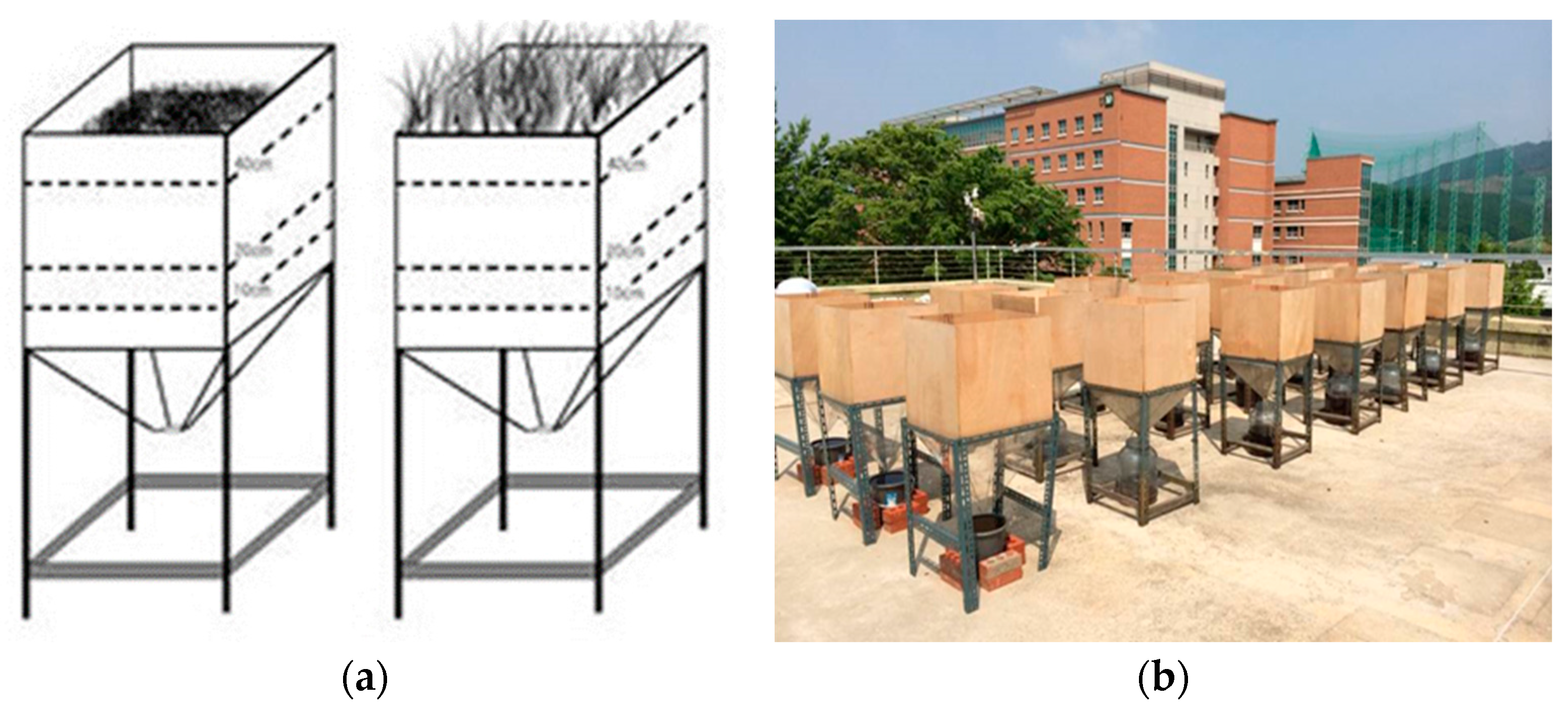
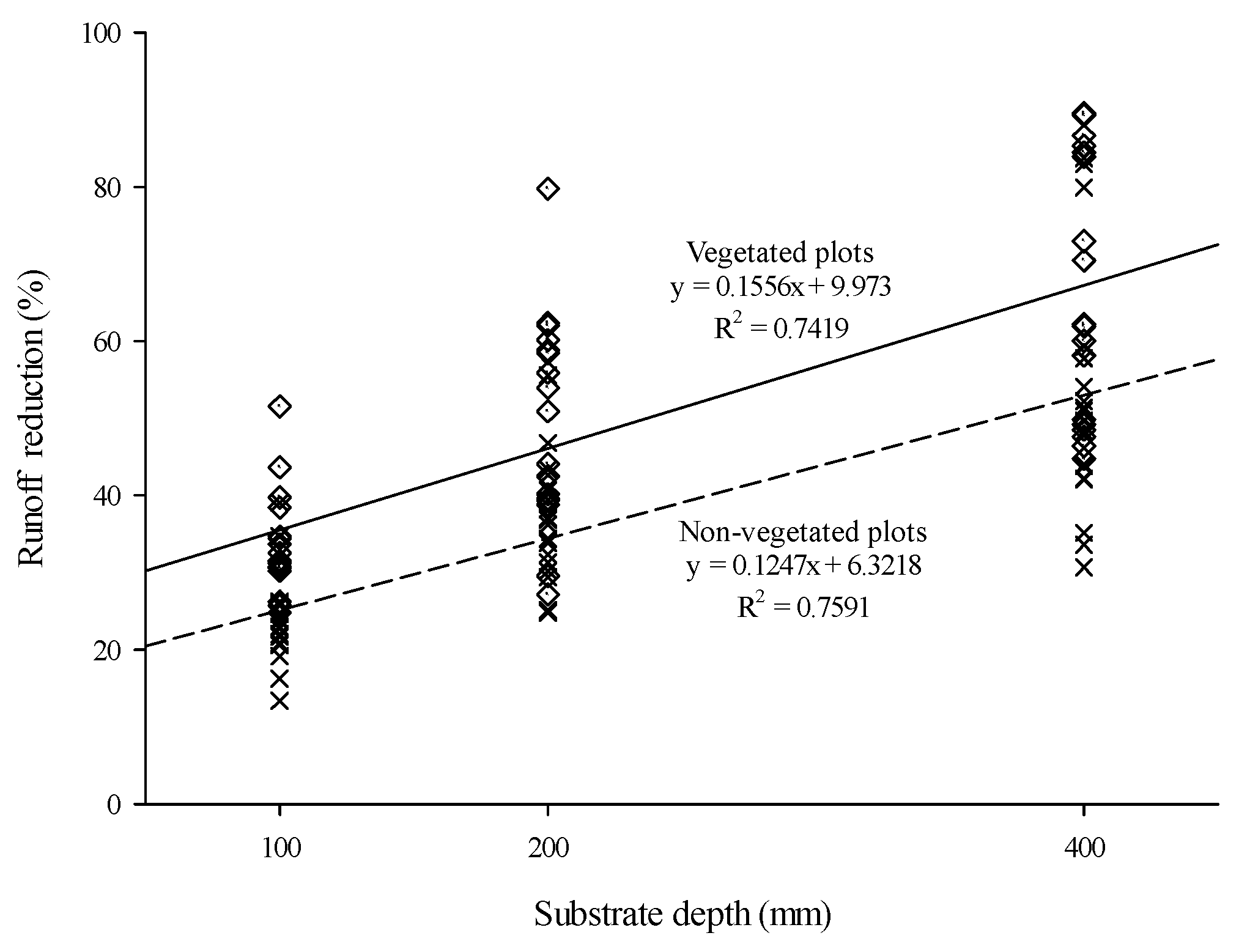
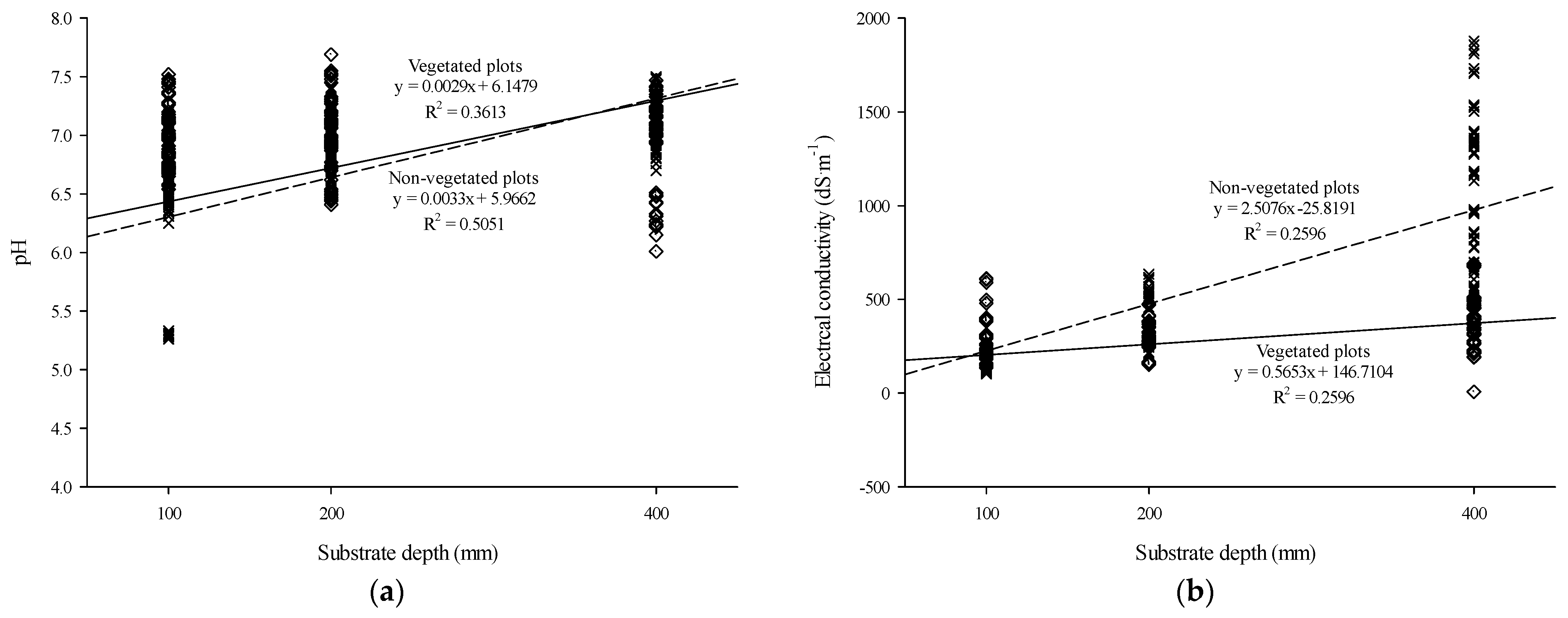
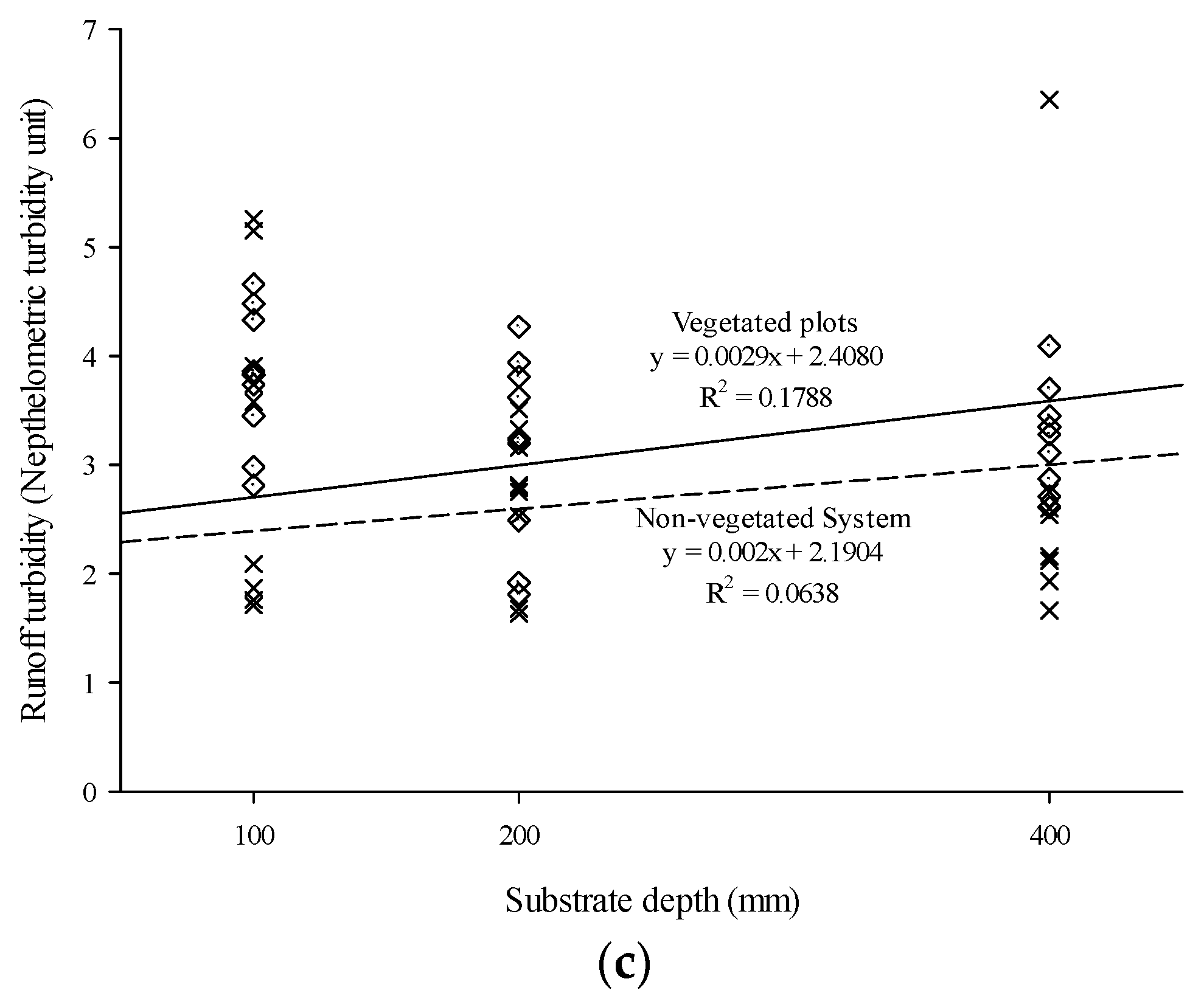
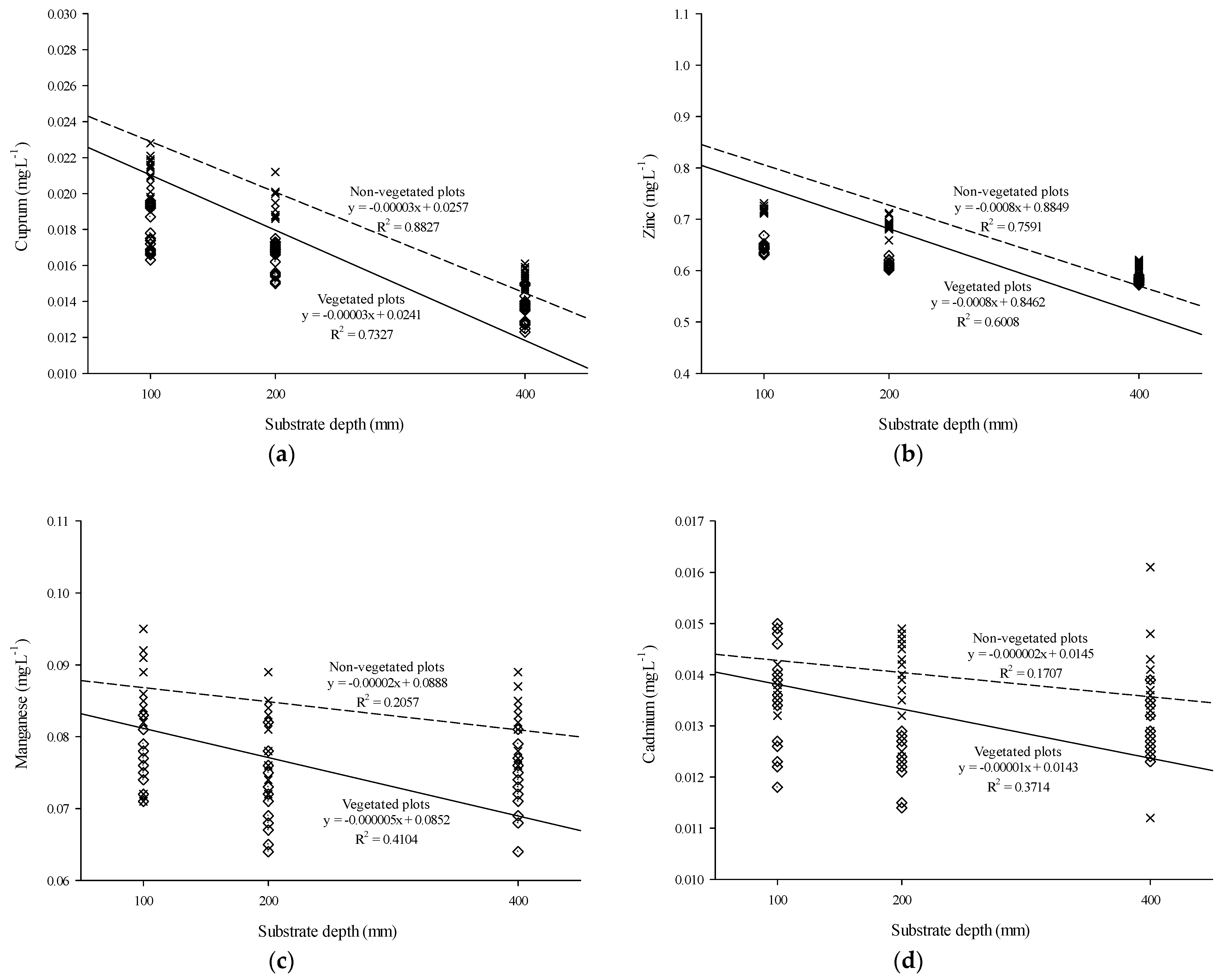
| Treatments | June | July | August | |||
|---|---|---|---|---|---|---|
| Runoff (mL) | Reduction (%) | Runoff (mL) | Reduction (%) | Runoff (mL) | Reduction (%) | |
| Cont. z | 14,567 a y | - | 14,233 a | - | 38,980 a | - |
| NV100 | 11,137 b | 24 f | 11,010 b | 23 d | 29,563 b | 24 d |
| NV200 | 8770 d | 40 d | 8657 c | 39 c | 25,993 c | 33 c |
| NV400 | 3907 f | 73 b | 6600 d | 54 b | 23,450 d | 40 b |
| V100 | 9950 c | 32 e | 9080 c | 36 c | 26,697 c | 32 c |
| V200 | 6910 e | 53 c | 6003 d | 58 b | 24,463 d | 37 b |
| V400 | 3170 g | 78 a | 2820 e | 80 a | 20,463 e | 48 a |
| Treatments | June | July | August | ||||||
|---|---|---|---|---|---|---|---|---|---|
| pH | EC (dSm−1) | Turbidity (NTU) | pH | EC (dSm−1) | Turbidity (NTU) | pH | EC (dSm−1) | Turbidity (NTU) | |
| Cont. z | 5.8 e y | 0.05 d | 1.25 c | 5.3 c | 0.09 d | 1.88 c | 5.8 e | 0.04 f | 1.43 b |
| NV100 | 6.8 cd | 0.20 c | 1.78 bc | 6.3 c | 0.22 cd | 3.25 ab | 6.7 d | 0.12 e | 4.66 a |
| NV200 | 7.0 ab | 0.36 b | 1.95 b | 7.0 a | 0.47 b | 3.15 ab | 6.8 c | 0.28 c | 2.96 ab |
| NV400 | 7.1 a | 1.34 a | 1.92 b | 7.2 a | 1.14 a | 2.47 bc | 7.0 ab | 0.64 a | 3.85 a |
| V100 | 6.9 bc | 0.31 bc | 3.21 a | 7.1 a | 0.36 bc | 3.89 a | 6.8 c | 0.17 d | 4.28 a |
| V200 | 6.9 bc | 0.25 bc | 2.07 a | 7.3 a | 0.37 bc | 3.46 ab | 6.9 b | 0.32 c | 3.90 a |
| V400 | 6.8 d | 0.34 b | 2.73 a | 7.2 a | 0.17 d | 3.36 ab | 7.0 a | 0.47 b | 3.63 a |
| Plots | June | July | August | |||||||||
|---|---|---|---|---|---|---|---|---|---|---|---|---|
| Cu | Zn | Mn | Cd | Cu | Zn | Mn | Cd | Cu | Zn | Mn | Cd | |
| Cont. z | 0.027 a y | 0.969 a | 0.093 a | 0.015 a | 0.028 a | 0.967 a | 0.091 a | 0.016 a | 0.027 a | 0.976 a | 0.092 a | 0.015 a |
| NV100 | 0.021 b | 0.717 b | 0.085 ab | 0.014 b | 0.021 b | 0.718 b | 0.083 b | 0.014 bce | 0.021 b | 0.719 b | 0.087 ab | 0.014 a |
| NV200 | 0.019 c | 0.691 c | 0.083 bc | 0.014 b | 0.019 c | 0.688 c | 0.081 b | 0.014 bc | 0.019 c | 0.687 c | 0.082 bc | 0.014 a |
| NV400 | 0.015 e | 0.612 e | 0.083 bc | 0.014 b | 0.015 d | 0.610 e | 0.081 b | 0.013 cde | 0.015 de | 0.613 e | 0.085 bc | 0.014 a |
| V100 | 0.018 d | 0.641 d | 0.077 d | 0.014 b | 0.018 c | 0.647 d | 0.074 c | 0.015 ab | 0.018 c | 0.642 d | 0.080 c | 0.014 a |
| V200 | 0.016 de | 0.619 e | 0.073 d | 0.012 c | 0.016 d | 0.613 e | 0.070 c | 0.012 e | 0.016 d | 0.611 e | 0.069 d | 0.013 b |
| V400 | 0.013 f | 0.581 f | 0.073 d | 0.012 c | 0.014 e | 0.580 f | 0.073 c | 0.013 de | 0.013 e | 0.582 f | 0.074 d | 0.012 b |
Publisher’s Note: MDPI stays neutral with regard to jurisdictional claims in published maps and institutional affiliations. |
© 2022 by the authors. Licensee MDPI, Basel, Switzerland. This article is an open access article distributed under the terms and conditions of the Creative Commons Attribution (CC BY) license (https://creativecommons.org/licenses/by/4.0/).
Share and Cite
Park, S.-Y.; Oh, D.-K.; Lee, S.-Y.; Yeum, K.-J.; Yoon, Y.-H.; Ju, J.-H. Combined Effects of Substrate Depth and Vegetation of Green Roofs on Runoff and Phytoremediation under Heavy Rain. Water 2022, 14, 2792. https://doi.org/10.3390/w14182792
Park S-Y, Oh D-K, Lee S-Y, Yeum K-J, Yoon Y-H, Ju J-H. Combined Effects of Substrate Depth and Vegetation of Green Roofs on Runoff and Phytoremediation under Heavy Rain. Water. 2022; 14(18):2792. https://doi.org/10.3390/w14182792
Chicago/Turabian StylePark, Sun-Young, Deuk-Kyun Oh, Sun-Yeong Lee, Kyung-Jin Yeum, Yong-Han Yoon, and Jin-Hee Ju. 2022. "Combined Effects of Substrate Depth and Vegetation of Green Roofs on Runoff and Phytoremediation under Heavy Rain" Water 14, no. 18: 2792. https://doi.org/10.3390/w14182792
APA StylePark, S.-Y., Oh, D.-K., Lee, S.-Y., Yeum, K.-J., Yoon, Y.-H., & Ju, J.-H. (2022). Combined Effects of Substrate Depth and Vegetation of Green Roofs on Runoff and Phytoremediation under Heavy Rain. Water, 14(18), 2792. https://doi.org/10.3390/w14182792






